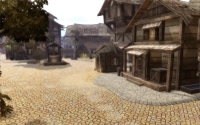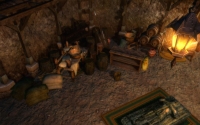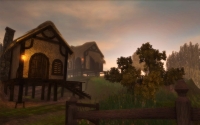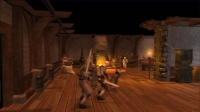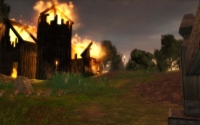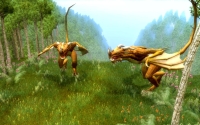|
Neverwinter Nights 2 Interview
Brian 'Dhruin' Turner, 2006-01-11 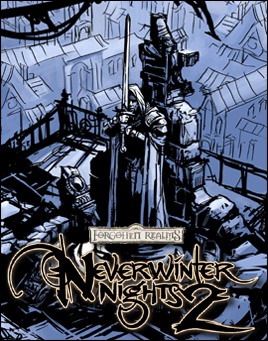
Years after the original release, BioWare's ambitious Neverwinter Nights continues to attract a huge community of regular players and module creators. With the sequel passing to the experienced Obsidian Entertainment, we had the chance to ask Producer Darren Monahan some questions, with additional input from Creative Director Chris Avellone and Lead Designer Ferret Baudoin. There's a lot to cover - from the single-player campaign to multiplayer to the powerful toolset, so read on...
RPGDot: As the producer of NWN 2, can you tell us a little bit about what your role entails and how your team is made up?
Darren Monahan: At Obsidian, the producer is in charge of the development team and interfacing with the outside world. My job is made up of being the project's manager, scheduler, "lead gamer", outside contact liaison, and the repository for Tasks with No Home.
The company is set up in a pretty typical corporate pyramid structure with the producer managing the team's leads (lead programmer, lead designer, lead artist, etc.) and the overall schedule for the game.
As "lead gamer" I try to be the compass for the team that makes sure decisions we make are for the good of the gamer, and lastly I am the point man for all outside contacts, such as audio, localization, publisher production, marketing, public relations, etc.
Our team here at Obsidian is made up of nine engineers, seven designers, five scripters and approximately eighteen artists including animators. We also have three production QA testers and are hiring now for full time, on-site QA ( sorry no public betas quite yet! :) ) We also have three producers on the project that help take on the odd tasks that don't necessarily fit well into one of the other departments.
RPGDot: BioWare's NWN and expansions were hugely successful. How do you approach a sequel in a way that stays true to the original, while still making it an Obsidian game? What high-level goals did your team want to achieve?
Darren Monahan: Originally we scoured the BioWare forums and many fan sites to see what the community wanted from NWN. On one side of the spectrum, fans wanted to see the single player campaign grow. They wanted their henchmen to come alive ( and not be "moving pieces of meat" as I just read in a comment recently on a forum :) ) and have real personalities, much like BioWare did with the expansions. They also wanted a lot more flexibility, control and customization options in the toolset.
We decided at that point that we'd split the focus of our efforts on the sequel down the middle. We wanted to create the next best RPG for 2006, but also maintain Neverwinter's reputation for being the RPG toolset of choice.
Decisions we made about the game were based on how we could extend what BioWare gave the community in the first game. We didn't aim to change what NWN was but rather to grow it further.
RPGDot: The inclusion of up to three "companions" that can be player-controlled instead of the original henchmen sounds like it could have a fundamental impact on the core gameplay. How deeply woven into the gameplay are the companions in terms of story, quests and combat and does this broadly mark a return to the sort of "classic" party-based combat we saw in titles like Baldur's Gate?
Darren Monahan: The companions in NWN2 are an integral part of the story and gameplay. I'd liken the new controls to a mix between Baldur's Gate and Star Wars: Knights of the Old Republic II: The Sith Lords. The player will carve out who they are, and their companions will react to what the player does and says, and can be influenced into doing things they might not have done before they met the player.
RPGDot: Previews have indicated you will include an Influence system along the lines of Star Wars: Knights of the Old Republic II. How have you refined the concept and can you provide some examples of how Influence will work in NWN2?
Chris Avellone (Creative Director): We've made the influence system more widespread than in Star Wars: Knights of the Old Republic II: The Sith Lords, but the fundamental mechanic is a little different - while you cannot corrupt others like you could in the KotorII, your decisions whether alignment-based, goal-based, or even favoring one companion over another can cause some companions to open up to you more, while others close themselves off to you.
RPGDot: Alignment and morality are to play expanded roles - is this a version of the "good vs evil" paths in KotOR2, or does it go deeper? Does it play into Influence?
Darren Monahan: I can't give a specific example, but I can say that NWN2's alignment changes are a part of the system. In NWN2, alignment is no longer something you choose at character generation - it's something you earn through the things you do and say. Your character gravitates toward law or chaos, good or evil based on these choices. Our influence system ties heavily into this and your companions will react to how you present yourself in the game.
RPGDot: Some of the NWN2 team members have worked on titles like Planescape: Torment, which featured quite complex dialog and NPC interactions. How much of this sort of design philosophy has carried over into NWN2 or does a modern D&D title need to be more accessible and reach a wider audience?
Darren Monahan:I wouldn't say that NWN2 necessarily needs to be more accessible, I personally see NWN2 within the class of harder core RPG's like Baldur's Gate, Fallout, and Planescape: Torment. I think we've taken the things we've learned from working on and playing these games to make sure the experience we're providing is fun to not only the hardcore D&D fan, but that folks who don't like to listen to mountains of dialog aren't put off. I push the guys to minimize how much text is used, but we have some of our most complex dialog written in any of our RPG's in NWN2.
RPGDot: Will NPCs exhibit any advanced behaviours? Will they recognise or react to the player's actions in any way? Are they influenced by reputation or factions within the gameworld? What about NPC schedules or other elements to simulate a more living world?
Ferret Baudoin (Lead Designer): Some NPCs will react to a variety of factors. They'd meet one barometer of being alive - they respond to some stimuli. :) Don't expect them to respond to everything ("My word, the hero ordered the veal. Everyone - he ordered the veal!") but big events and choices can have big consequences.
There aren't schedules in our game - we want to make it so it's quick and convenient to find the important people in the game. So you can get back to adventuring and your important business. Cities and towns do have life, though, people will wander around, chat with each other, talk with the shopkeeper, and more.
RPGDot: Obsidian has said that the player will start as unimportant and have to work to gain stature. This seems to imply a more open story structure - how linear is the story and how much freedom do players have to move around the gameworld? Is the story divided into discrete chapters?
Darren Monahan: Yes, the story is divided into separate Acts, but I'd liken it more to Baldur's Gate II, where you could complete some quests in chapter 2 or chapter 6 depending on when you wanted to do them. We've also added an overland map (and overland map editor for the community) which allows for easier travel between the various hubs within the game (as well as you guessed it, random encounters!)
RPGDot: What is the balance between combat and the other elements like exploration or dialogue? How often do quests have different solutions, including non-combat outcomes?
Ferret Baudoin (Lead Designer): There's more dialogue and story in Neverwinter Nights 2 than it's predecessor. So diplomatic characters are going to have a lot more moments to shine and strut their stuff. But we're trying to be considerate to the would-be Conans out there and making it so they can cut to the chase and get back to glorious combat and dungeon delving - of which there is a ton. Many of our quests have alternate solutions and combat can be averted entirely. We're trying to make sure that the diplomatic player gets rewarded appropriately for avoiding combat, too, otherwise it's a bitter sweet victory as they wave all the loot and experience points goodbye. But sometimes in the Realms, some folk just needs killing.
RPGDot: Can you expand on the role of the player stronghold?
Darren Monahan: Unfortunately, not quite yet, but we do have a bunch of information scheduled to come out about it over the next few months!
RPGDot: Has the team been able to find ways to enhance the multiplayer experience? Will you continue to use GameSpy for connecting to multiplayer games and has this been refined in any way?
Darren Monahan: When we first started development on NWN2, many of us at Obsidian had been playing World of Warcraft, and had just gotten off stints of EverQuest, DAoC, and even Ultima Online (Corp Por!) Needless to say, MMORPG's were fresh on our mind.
Now in spite of that, we didn't want to make NWN2 an MMO - that didn't seem like the right thing to do. But we did want to bring some of the interface and control elements of MMO's to NWN2 and expand what BioWare had already put in place.
Feargus (Obsidian's CEO), Ferret (NWN2's lead designer), Frank (NWN2's lead programmer) and I extensively played NWN1 again in multiplayer and came up with ideas for making the play experience feel more like an MMO, minor things like expanding emotes (/dance, /cheer, etc.) to interface customization.
Players will find features that were influenced from popular MMO's in NWN2, but to be clear, our goal wasn't to make an MMO out of the game, we wanted to provide some of the options available in MMO's though that NWN1 didn't have.
We're still planning to use GameSpy for multiplayer game connections. The underlying architecture for multiplayer games hasn't changed much in NWN2. BioWare did a fantastic job with the networking layer in NWN1.
RPGDot: Moving on to the toolset, can you explain what a "height map" is and detail how the new system works for creating locations? Can you give us an idea of the textures/tilesets that will be available out of the box?
Darren Monahan: Sure - There was a toy I used to play with as a kid that was basically a large 8 inch by 8 inch square with a bunch of pins in it. I think they were called Pin Sculpture Toys but I'm not really sure. (An image of one is here!) You could push the pins up from underneath the toy, and it would appear to conform to your hand.
Height maps (or height fields) work very much in the same way. When you create a new level in our toolset, it's flat and is made up of a bunch of invisible points. The user influences these points by using our brush tools; they can raise or lower these points. These points are saved out into a graphic map, and when the game loads, it starts with a flat level and pushes and pulls the points according to how the modder painted the level. This gives a much more organic feel to exterior levels, and in my opinion, is a quite fun way to make levels.
As far as textures, we'll have a whole slew of palette options: multiple kinds of sand, dirt, mud, road, grass, rock, and cliff textures. Users will very easily be able to add their own as well.
For interior tilesets, we'll have a lot of the common ones found in the first game, as well as a few specifically for NWN2.
I must unfortunately report, however, that there is no sewer tileset planned for NWN2. I know RPG's can't be RPG's without rats in sewers with crates to break open, but NWN2 isn't going there. :)
RPGDot: You've said that existing dialogue and scripts can be imported into NWN2 and existing modules can be ported with "minimal fuss" - what does this mean, exactly? What about converting art assets?
Darren Monahan: We've kept mum about this for awhile, because we don't want to promise the world on this one. Unfortunately keeping complete parity with NWN1 modules will be impossible given the changes to exteriors, the upgrade to 3.5 rules (as many skills, feats and spells have changed), as well as other technical issues that make it not a simple upgrade path.
We are however taking great pains to insure users can import their dialogs and scripts, which are often the bulk of time-consuming work. We can't guarantee this until we ship, but that's still our goal.
RPGDot: How powerful is the new conversation editor and what sort of things can module builders achieve in dialogue without additional scripting?
Chris Avellone (Creative Director): The ability to cut and paste global scripts throughout the dialogue and have generic scripts that you simply plug numbers into is a blessing. By this I mean, if you need a script that checks to see if a player's intelligence is over a certain value, there's a generic script you can use that allows you to enter a field number for any value you want right in the conversation editor… even easier, this same script allows you to enter numbers for specific stats, too, so you can actually have a generic script that checks any stat for any number, and you can use it with a minimum of fuss. Also, the ability to cut and paste these scripts all over the dialogue is awesome.
In addition, these generic scripts function like lego blocks as well - instead of writing a single script that combines a stat check with a skill check and also checks to see what the player's gender is, you can actually stack three generic scripts on top of each other for one node in the editor, and it will check them all in sequence. It makes scripting much, much easier.
RPGDot: Prefabs and stackable items sounds intriguing - what can this system achieve?
Darren Monahan: NWN2 is populated heavily with placeables, objects that can be placed into the world and oriented in any way the user desires. With pre-fabs, users can create groups of placeables that preserve their position, and can be placed as objects in other levels. As an example, a prefab can be as simple as a torch, with an attached light, sound effect, and smoke particle system. So whenever you place this torch pre-fab, it comes with everything associated with it. You can take that to the next level, by creating a prefab that is a let's say someone's room. If you wanted to create a "default bedroom" that fits into a tile, you could lay it out how you want, group the items and create a prefab. Then when you want to make other rooms, you can simply place down this prefab without having to again place down the bed, dresser, tables, chairs, rugs, etc.
Stackable items allow you to create rooms that appear as they would in the real world. As an example, we have desks that can be placed in the world. We also have a variety of desk accessory placeables, such as unfurled maps, scrolls, potions, alchemist kits, and more. You can make your own workshop areas by placing any placeable on top of any other placeable. It allows for a lot of fine customization, should you want to do that.
RPGDot: There are a number of additional facilities such as the skinnable UI and cutscene creation tools; it seems Obsidian is trying to provide the tools so builders can create a complete package or experience and not just a "module". Is this one of your goals?
Darren Monahan: Absolutely, expanding customization in NWN2 was a huge goal of ours. We've also introduced the concept of the Campaign. Modders can now make multiple modules that are associated with one another, which supports a unique 'Override' directory just for that campaign. This allows modders to have a custom interface, customized changes to the rules for the game, and wrap it up into a nice neat package. If we create expansion packs or modules for download, they'll basically be separate campaigns, just like modders would create.
RPGDot: Where does the issue of Linux server support stand?
Darren Monahan: I can say that we have several big Linux fans on the team, but unfortunately no comment at this time. :(
RPGDot: BioWare supported NWN with a Live Team and ongoing patches - do you have any specific plans for ongoing support with NWN2?
Darren Monahan: Nothing we can talk about quite yet, but we've already… well… um, yeah, can't say anything yet. :)
Thanks to Darren Monahan, Chris Avellone and Ferret Baudoin from Obsidian for answering our questions and Josh 'Moxie' Sprague and Suzie 'Kalia' Ford from the RPGDot team for their assistance.
RPGDot interview with Chris Avellone on story-telling in NWN2
Obsidian Entertainment
|






